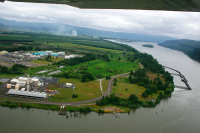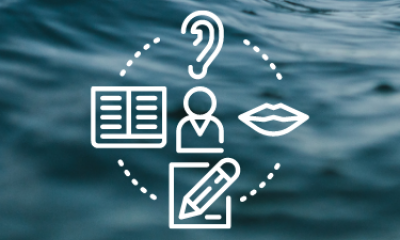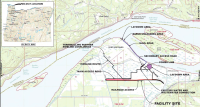At a critical bend in the Columbia River Estuary, a company called NEXT Renewable Fuels, Inc., is seeking to build a new, massive renewable diesel refinery.
More Industrialization of Port Westward? What's Next?

At a critical bend in the Columbia River Estuary, a company called NEXT Renewable Fuels, Inc., is seeking to build a new, massive renewable diesel refinery. Renewable diesel requires more refining than biodiesel, and the proposed refinery at Port Westward would be one of the largest producers of renewable diesel on the West Coast.
Until December 4, Oregon DEQ and the Army Corps will be accepting comments on Clean Water Act permits for the project.
For more background on the project and information on how to comment, check out our FAQ on NEXT.

Info on how to comment is in the public notice. Submit comments to the Corps this way:
U.S. Army Corps of Engineers, Regulatory Branch, Mr. Joe Brock P.O. Box 2946 Portland, Oregon 97208-2946
Email: joseph.w.brock@usace.army.mil; Telephone: (503) 808-4377

Written comments on project elements related to water quality must be received at the Oregon Department of Environmental Quality by 5 p.m. on December 4, 2021. Written comments may be submitted electronically through “Your DEQ Online” web page. For questions regarding account registration, system navigation, or training resources, please visit the Your DEQ Online help webpage.

On January 5, 2022: expected to conduct initial hearing on NEXT’s land use applications. Agenda available soon. TBD: Columbia County Board of Commissioners expected to make decision on NEXT’s land use applications.
2022 outlook: Key state and federal permitting processes will continue through 2022.
Frequently Asked Questions About NEXT Energy
This FAQ addresses basic questions about NEXT Energy, a proposal to build a renewable diesel refinery in the Columbia River estuary at an industrial site known as Port Westward. Columbia Riverkeeper does not support siting of NEXT Energy at Port Westward based on the development’s significant impacts to local residents, water resources, air quality, and the troubling track record of the company.
What is proposed?

At a critical bend in the Columbia River estuary, a company called NEXT Renewable Fuels, Inc., wants to build a renewable diesel refinery. Renewable diesel requires more refining than biodiesel, and the proposed refinery at Port Westward would be one of the largest producers of renewable diesel on the West Coast. Renewable diesel is a form of biofuel that is more easily used to replace diesel than conventional biodiesel. The process of converting feedstocks into a diesel fuel will demand power, fracked gas, and water.
The Port Westward project would rely on transportation by water, railroad, and road to receive materials used in production (feedstock oils, tallows, bleaching earth) and to ship renewable diesel produced from the facility. Through an energy-intensive process—using a significant amount of fracked gas—the project would produce 50,000 barrels per day of renewable diesel and other fuels.
NEXT would impact over 137 acres of wetlands, and its proposed mitigation plan has received sharp criticism from the local drainage district and farmers. The process of constructing the NEXT facility and its pipelines for liquid fuel and gas, as well as other supporting infrastructure, will involve grading, filling, and altering wetlands and sensitive drainages at Port Westward. Construction of the NEXT project would impact neighbors, as well.
What does the area look like where NEXT proposes its refinery?
The area known as Port Westward, Oregon, is located closest to the town of Clatskanie at a deep bend in the Columbia River.
The area is diked, and large areas of agricultural land are maintained through a system of sensitive drainage infrastructure. Local farmers in the diking district do not support NEXT or its mitigation proposal because of concerns about natural resource and water impacts.
Is the NEXT project the only industrial project at Port Westward?
No. Industrial developments at Port Westward include PGE’s gas-fired power plants and Global Partners, which receives ethanol and renewable diesel trains. The Port of Columbia County wants to rezone 837 acres of high-value farmland adjacent to Port Westward to heavy industrial zoning. If the rezone moves forward, Northwest Innovation Works (NWIW) proposes to build a fracked gas-to-methanol refinery at the expanded Port Westward site.
Who lives at or near Port Westward, and who depends on it?
Port Westward is located in the midst of abundant berry fields, world-class mint production, forestry, salmon habitat, sensitive drainages, dikes, liquefiable soils, and current and historic fishing grounds. NEXT’s proposed developments are close to people’s homes, businesses, and rural, natural public gathering places.
Here are some additional notes about the area:
- Port Westward is a critical bend in the Columbia River for Tribes, salmon, farmers, and the entire Columbia River system. The area is home to local farmers, residents, a monastery, and visited frequently by agricultural and other workers.
- Nearby, Crims Island is a jewel of the Columbia River estuary restoration efforts. Homes are perched on the hillside on the bluff on the Washington side of the river.
- Air and water pollution from the area has the potential to impact a large and sensitive area of the Columbia River estuary. The Columbia River estuary is a critical area for salmon survival and recovery, and Port Westward continues to be used for fishing, boating and other uses. The area is very important for wildlife.
- Port Westward faces significant flooding and earthquake risks, and the area’s peat soils are prone to liquefaction.
- Local farmers have opposed the NEXT facility and its mitigation site outright: you can find more about their concerns at protectoregonfarms.com.
How does renewable diesel compare to diesel or biodiesel?
The lifecycle carbon content of biodiesel and renewable diesel are similar, and lower than, conventional diesel. However, burning any of these forms of diesel releases air pollutants that are harmful to vulnerable populations. Diesel particulates and other pollution created by the production raise questions about air quality impacts for communities that will experience a lot of diesel-burning vehicle traffic. Vehicle electrification is an agreed-upon critical path to limiting global warming and avoiding the worst impacts of climate change.
Would local residents’ health and safety be impacted by NEXT?
Yes, the NEXT project would impose significant construction and operation-related impacts on people in the area and downstream or downwind from the Port Westward site.
Rail traffic is a serious concern. Although NEXT contends that it hopes to cap its rail traffic at current levels, there is no firm guarantee. Although NEXT hopes to receive its feedstock (seed oil or tallow/waste products) and export its product (renewable diesel) via marine vessel, the company acknowledges that long trains will be used “on a limited basis” for feedstock receipts and product shipments. NEXT also plans to truck renewable diesel away from the site.
NEXT’s proposal opens the door to more long train traffic and other transportation impacts for Port Westward and Columbia County. The troubling history of Global Partners’ terminal, once an ethanol refinery, offers a compelling example for why the public should ask for more details about the NEXT project. For example, NEXT’s potential neighbor, Global Partners, once a biofuels refinery, became a significant oil train terminal almost overnight in 2013-2014.
There are already significant risks for people living in the area due to unstable soils, a high water table, and sensitive drainage systems. The Port Westward area is prone to soil liquefaction, landslides, flooding, and other hazards that could exacerbate any public health or safety issues that arise with NEXT.
Have impacted Tribal Nations weighed in on this proposal?
Given the relatively few opportunities to comment directly on NEXT thus far, not many governments or people are on the record supporting or opposing this project directly. There are major questions about the NEXT project, its design, impact, and its mitigation project. We urge key agencies to give adequate information and time for tribes to engage and to seek input from tribal entities before proceeding with decision-making on the NEXT project.
How much pollution will come from the facility?
DEQ is in the process of reviewing this issue, but refers to the NEXT project as a “large, complex” source. Until DEQ puts NEXT’s proposed permits out for public comment, we won’t know for sure what the expected environmental impacts will be. A lot will depend on the overall fracked gas combustion and use of the facility, which originally planned to use up to 30 million cubic feet of gas per day for the refinery as a whole.
What we do know, however, is that the project will demand a large quantity of power and fracked gas to upgrade the feedstocks into diesel. DEQ expects that the combustion of fracked gas will be the major driver for pollution from the NEXT site. Burning fracked gas both provides energy for converting the fuel, as well as potential energy for producing hydrogen used in the refining process. Burning and using fracked gas often contributes to smog-forming pollution and other air emissions. Other facilities of this size are major sources of air pollution. DEQ expects the NEXT facility to emit over 70 tons of VOCs per year, for instance.
The project will also discharge wastewater into the Port’s wastewater system, combining with other area facilities to create more water pollution that would have to be treated on a regular basis.
The pollution will combine with other existing and potential sources of air and water pollution, including PGE’s nearby fracked gas power plants, the Global Partners’ ethanol refinery and train terminal, and a lurking proposal for a new, massive, fracked gas-to-methanol refinery.
Who decides the future of NEXT?
The key decision-makers for this project are:
- Local - The Columbia County Commission will decide on the land use applications for the project. This process will kick off in earnest on January 5, 2022, the date of NEXT’s likely first hearing in front of the Board of Commissioners.
- State - Oregon Department of State Lands (DSL), Oregon DEQ, and other state agencies will review air, water, removal-fill, mitigation, and other permitting aspects of the project. They will decide whether NEXT’s proposal complies with Oregon’s environmental laws. Oregon’s Energy Facility Siting Council (EFSC) will also have a decision to make, as NEXT has asked EFSC to exempt the facility entirely from Oregon’s siting review standards.
- Federal - The Army Corps of Engineers will review the removal-fill aspects of NEXT refinery project and its mitigation project, and NOAA Fisheries and other agencies may review other aspects of the project’s impacts on fish and wildlife. They will determine whether the project meets these agencies’ requirements for the Clean Water Act, Endangered Species Act, and National Environmental Policy Act (NEPA). We expect federal agencies to release an environmental analysis in 2022.
What can I do to learn more and to take action?
Through 2022, there will be a number of permitting comment periods for the different agencies listed above.
- Right now, the Army Corps of Engineers and Oregon DEQ are accepting comments on the project. All written comments are due December 4, 2021. Through their respective Clean Water Act reviews, the Army Corps and Oregon DEQ will decide whether the NEXT project will meet Oregon’s clean water and other environmental standards.
- In January 2022, the Columbia County Board of Commissioners will begin its initial hearing of NEXT’s local land use applications. The first hearing is scheduled for January 5, 2022.
Resources:
- Public notices for the Army Corps and Oregon DEQ Clean Water Act comment period open until December 4.
- State of Oregon’s pages here:
- DEQ Web Page;
- DEQ overview presentation;
- EFSC Web Page
- DEQ denial of NEXT’s 401 certification (without prejudice)
- CRK comments to DSL on NEXT’s dredge/fill permit application.
- Contact dan@columbiariverkeeper.org for more information on past comments to the Port and County regarding land use or Port decision-making.


